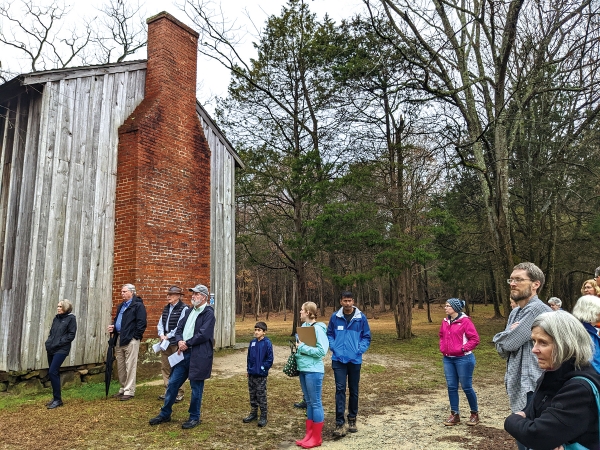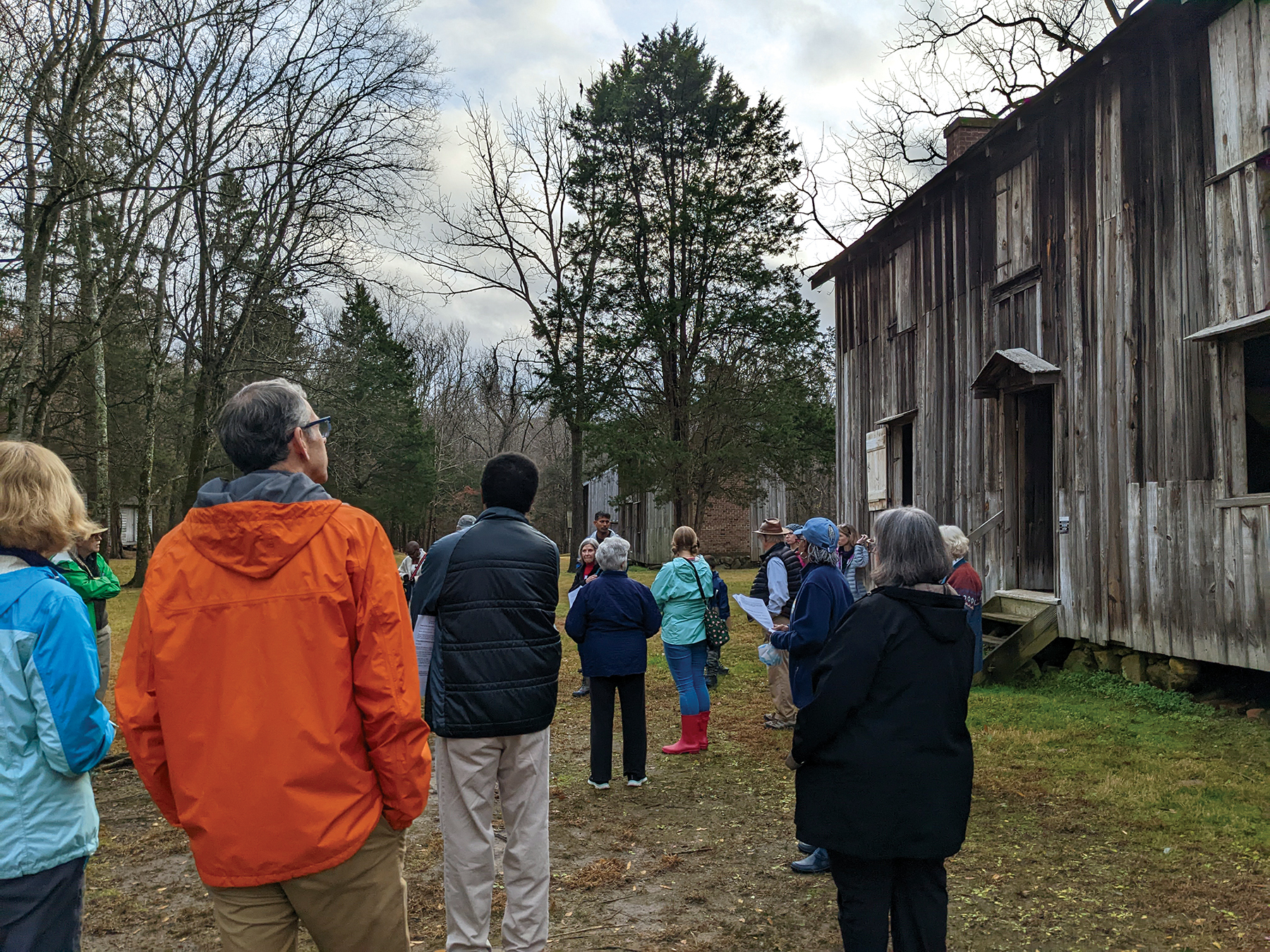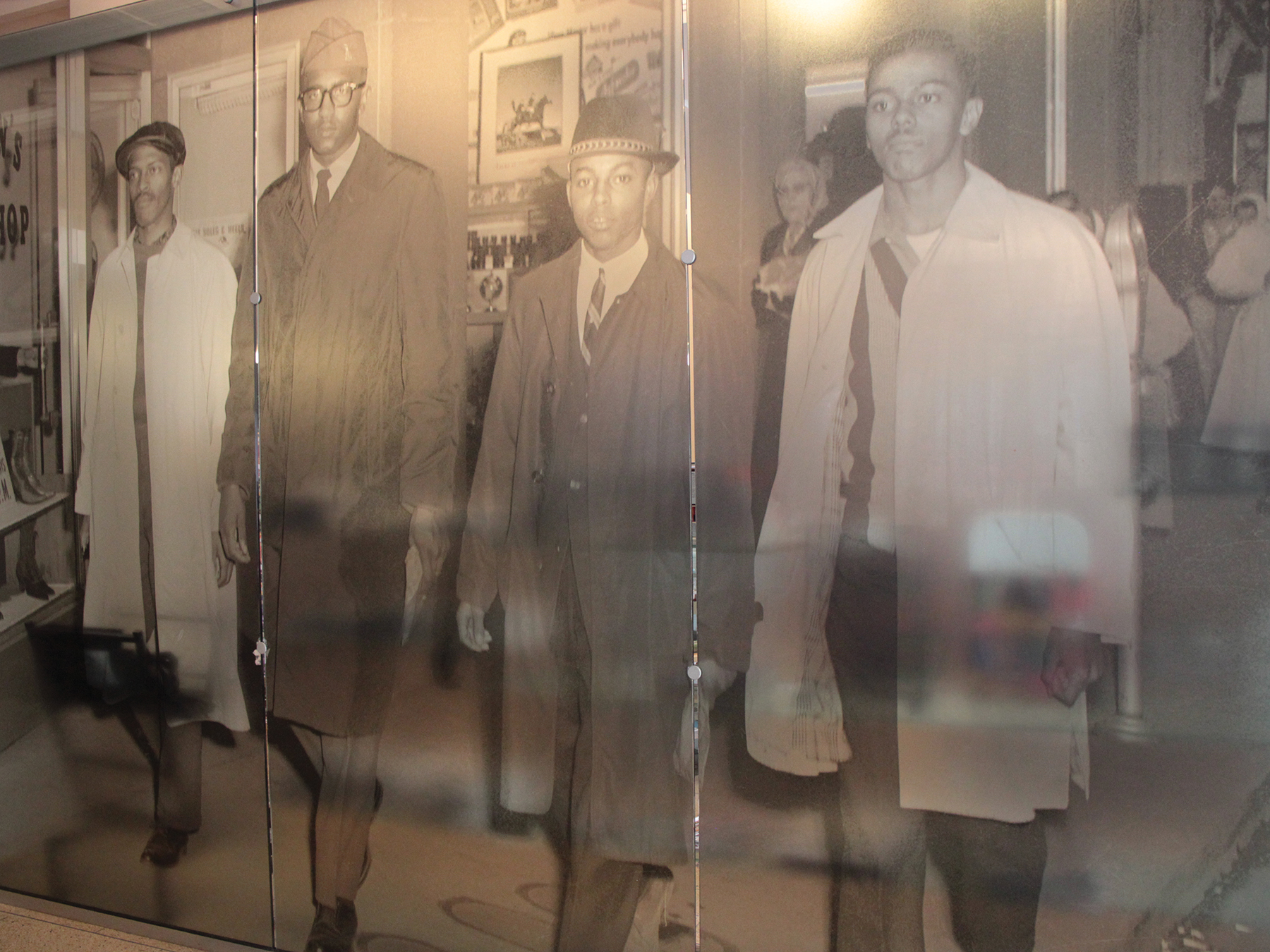Disciple: The Power of Pilgrimage

Walking in the footsteps of the past
By Beth Crow and the Rev. Monnie Riggin
There is nothing quite so sacred or moving as walking on the path and in the footsteps of those whom history has not treated with dignity and grace. This sacred journey, often referred to as a pilgrimage, dates back to antiquity and is a practice viewed by many world religions, including Christianity, Judaism and Islam, as a sacred path on holy ground. Often these journeys are spiritual quests, walking along the paths of iconic religious leaders as one seeks deeper understanding and leadership with God. Pilgrimages help us better understand history and those whose lives were deeply impacted by injustices committed to groups of people or individuals. Deepening our understanding in this way has been the goal of the diocesan pilgrimages offered this year.
[Image: During the diocesan pilgrimage to Durham’s Historic Stagville, a former plantation, in December 2022, pilgrims learned about the lives of the enslaved people who labored on the plantation and gathered for worship to reflect on what they had experienced. Photos throughout by Jenny Beaumont]
In the Diocese of North Carolina, as an important part of our mission strategy goals, we have a profound opportunity to educate ourselves about what has happened in our diocese concerning race and the lack of justice.
It is important to note that a pilgrimage is not a vacation or a field trip; rather, a pilgrimage is a personal and intentional spiritual and introspective journey, whereby transformation of the soul and mind can occur. It is a transformational journey during which significant changes will likely take place.
One objective of a pilgrimage is to bring a sense of displacement from your normal environs—a sense of being in a wilderness—so that when moments of sacred encounter occur, we may hear God’s voice in a way we have never heard it before. We pray that our pilgrimages will begin to allow us in some small way to sense and empathize with the struggle of enslaved people and their descendants, whose feelings of displacement are the norm, rather than the exception.
INTENTIONAL CHOICES
With pilgrimages established as a mission strategy goal for the priority of Racial Reckoning, Justice and Healing, the pilgrimage subcommittee of the Chartered Committee for Lifelong Formation began planning pilgrimages throughout our diocese, offering the first in late 2022: a trip to Durham’s Historic Stagville in December. In March 2023, another pilgrimage was led to the International Civil Rights Center & Museum in Greensboro.
Planning for a pilgrimage must be very intentional and prayerful. As the diocesan team discerned locations, schedules and speakers, we sought sacred places within our diocese where racial injustice became a landmark for its communities but also where the oppressed exhibited resilience and resistance. Historic Stagville and the International Civil Rights Center & Museum both possess these characteristics. Prior to each pilgrimage, resources were provided to registrants to prepare them for the journey to these sacred locations. The resources included videos, reflection questions, Scripture and prayers.

Historic Stagville preserves a small fraction of the plantation holdings of the Bennehan and Cameron families. From 1771 to 1865, the Bennehan and Cameron families profited from the forced labor of some 1,000 African and African American enslaved people on 30,000 acres of land. This plantation was one of the largest sites of mass slavery in North Carolina. As we stood in the Horton Grove quarters, one of the oldest sections of this vast plantation complex, pilgrims were able to see and touch the bricks that still hold the fingerprints of former enslaved people who built the two-story houses, each of which sheltered four families.
The tangible connection to the past holds power. “We have been involved in programs over the last few years learning about racism,” said pilgrim Margaret Pikaart of St. Joseph’s, Durham, “but seeing the faces and hearing more personal stories really touched the heart.”
[Image: During the diocesan pilgrimage to Durham’s Historic Stagville, a former plantation, in December 2022, pilgrims learned about the lives of the enslaved people who labored on the plantation and gathered for worship to reflect on what they had experienced.]
The International Civil Rights Center & Museum opened in 2010 with a mission to provide a comprehensive view of the Civil Rights Movement. The centerpiece is the “whites only” lunch counter, preserved as it was on February 1, 1960, during the historic sit-in by four North Carolina A&T students. Again, the site provided a tangible link to the past. “At one point during the tour, [tour guide] Darren started singing, ‘What the world needs now is love, sweet love,’” remembered Pikaart. “Such a simple message, but one to live by.”
The diocesan planning team intentionally sought a historically Black church in Greensboro to host our lunch, discussion and worship as part of our sacred path. Redeemer, Greensboro, a historically Black church established in 1906 when the Diocese of North Carolina decided that a mission was needed for the “colored” Episcopalians living in Greensboro, received full parish status in 1979. Redeemer often served as the meeting place for the civil rights organizers during the days of desegregation. Even the caterer for lunch was intentionally sought to uplift and highlight the success of the BIPOC community in Greensboro.
As part of the stop, a panel of three helped personalize the history witnessed at the museum. Through their stories, they illustrated both the struggles of the Black community in the 1960s and 1970s, as well as their courage, strength and faith.
Edna Rich-Ballentine, a member of St. Ambrose, Raleigh, was a student at Bennett College in the early 1960s. She described protesting at the local movie theater where Black people had to sit in the balcony. Rich-Ballentine was arrested and detained for seven days. She told the group how members of the college community brought them food, but rarely was it delivered to the intended recipients.

Lewis Brandon was a student at North Carolina A&T and participant in the 1960s Greensboro sit-ins. Brandon has spent most of his life working for equality for all races. He told the group, “I played a key role in formulating protest strategies during the Greensboro civil rights demonstrations of the 1960 Woolworth sit-in movement and again for the 1961 movie theater demonstrations.” In 2001, North Carolina A&T recognized Brandon with its first Human Rights Medal.
The Rev. Nelson Johnson was also a North Carolina A&T college student in the late 1960s. Johnson described how his military background equipped him with the leadership skills needed during the 1969 conflict at Dudley High School, which ended on the campus of A&T and the shooting death of one student by the National Guard. In 1979, Johnson led the labor and civil rights march that ended with five deaths and became known as “the Greensboro Massacre.” Johnson and Brandon are currently working on reviving the Greensboro Truth and Reconciliation Commission as well as supporting other communities in their efforts to establish their own. Each of the guest speakers shared with participants the importance of working in community, knowing your goal and placing God at the center of your decisions.
[Image: An image of the Greensboro Four inside the International Civil Rights Center & Museum's lobby. Photo by Summerlee Walter, 2019]
Reflecting on the guest speakers, Ty Novar, one of the youth from All Saints’, Concord, wrote, “I really liked hearing the three speakers give their stories on what happened. It was interesting to hear a first-person perspective. It made me feel, ‘Dang…they went through hell; it was a lot worse than people describe it.’ It inspired me that they were able to protest in peaceful and nonviolent ways.”
Jack Payden Travers, a member of St. Paul’s, Winston-Salem, felt a similar impact. “I am always amazed to hear from people who lived through events that are now historic,” he wrote. “[A]lthough I was alive at that time, I was oblivious to what was going on. It is humbling to meet these people face-to-face and realize the courage it took for them to sit in or march in the face of such danger.”
Said pilgrim Gary Kover of All Saints’, Concord, after the pilgrimage, “For a few days after, I found myself grieving. What I learned about the Civil Rights Movement growing up is simplified to the point of losing sight of the atrocities. Part of my Lenten journey has been unpacking where I can go from here. Where and how can I help in my local community?”
The participation and responses to these two pilgrimages illustrate the spiritual value and need for these journeys. There is a special power in walking in the footsteps of those who came before us, a power that undoubtedly brings us closer to God.
Let us pray.
Holy God, source of wisdom and grace: thank you for blessing us as we embarked into spaces of learning about struggles for the rights and dignity of our Black siblings. Thank you for giving us open minds to receive the truths—however hard—of ways we as a nation have failed to honor your presence in one another. Thank you for giving us tender and caring hearts to receive the sacred stories of the people who have persevered in the struggle to honor the dignity of every human made in your image; and all for your love’s sake. Amen.
- The Rev. Joyce Allen
Beth Crow and the Rev. Monnie Riggin are members of the pilgrimage subcommittee of the Chartered Committee for Lifelong Formation. Contact them via the communications department.
Tags: North Carolina Disciple / Racial Reckoning, Justice & Healing
